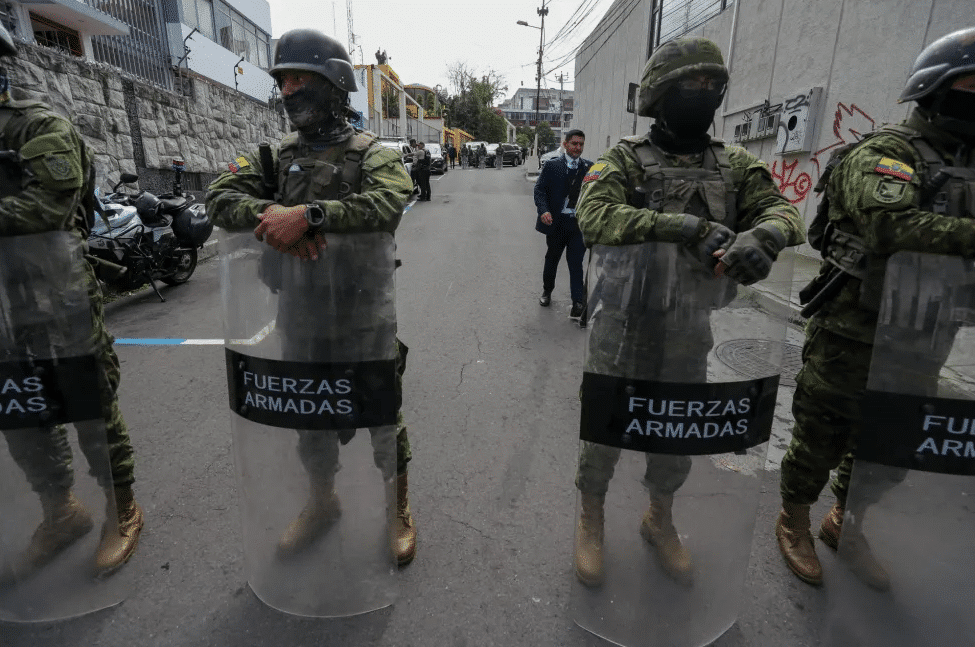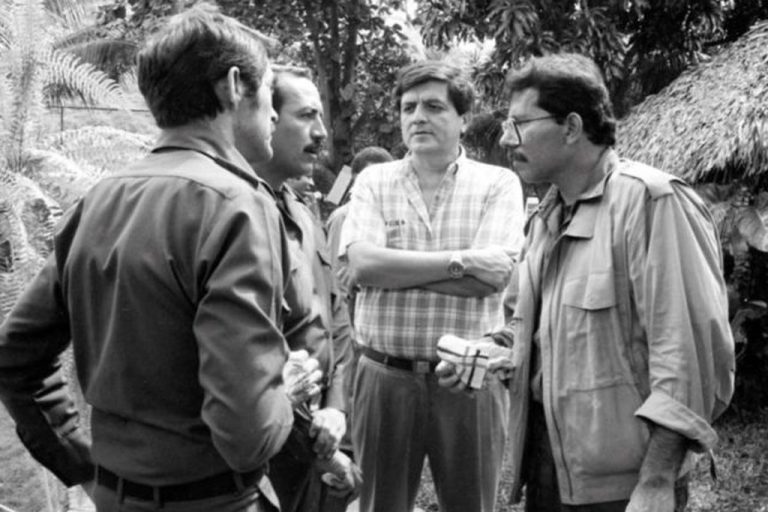15 de febrero 2022

The Return of the Military

PUBLICIDAD 1M
PUBLICIDAD 4D
PUBLICIDAD 5D
The former guerrilla participated in two military operations to free political prisoners, including the current dictator, Daniel Ortega, in 1974.

Hugo Torres participated in two military operations to free political prisoners
“Like many men and women, I stepped forward, I left my family and university studies to add my personal efforts to that of others, who like me, felt the blush of shame in their consciences and said enough of shame, of outrage and humiliation, of crimes and larceny. It is time for dignity, justice, and homeland.”
This is how he begins describing his involvement against the Somoza dictatorship in his memoir “Rumbo Norte. Historia de un sobreviviente” (Northbound: History of a survivor), former guerrilla Hugo Torres Jiménez, retired brigadier general and political prisoner by orders of Daniel Ortega and Rosario Murillo, who died at the age of 73, this February 12th, after more than two months in which the regime kept his whereabouts and health condition hidden.
Torres narrates in the book that “it was not easy to take that step,” because he had “to overcome prejudices and fears, face my parent’s fear and my own fear of suffering imprisonment and torture and losing my life at the hand of the dictator’s assassins.”
But he overcame that fear, which led him to be part of the guerrilla commando that carried out the operation “Diciembre Victorioso” (Victorious December), which consisted in assaulting the house of Jose Maria “Chema” Castillo, where a party of high officials of the Somoza dictatorship was being held. On December 24, 1974, several political prisoners were freed, among them Daniel Ortega.
“When he was chosen to be part of the ‘Juan José Quezada’ Commando, he spent months in seclusion and training until they carried out the Diciembre Victorioso (Victorious December) operation, in which they kidnapped high officials of the Somoza government who were attending a party at Chema Castillo’s house. The commando demanded the release of the political prisoners of that time. They achieved their objectives in less than 48 hours. Afterwards, they flew to Havana with the rescued political militants, among them Daniel Ortega, today his tormentor and current illegitimate president of Nicaragua,” wrote Monica Baltodano in an article entitled “Hugo Torres Jimenez: Hero of the Struggle Against the Somoza Dictatorship.”
Four years later, in 1978, he was part of the FSLN guerrilla commando that stormed the National Palace and allowed the release of another large group of political prisoners, among whom were Tomas Borge, Javier Carrion, Rene Nuñez and Doris Tijerino.
“He was selected to integrate the ‘Rigoberto López Pérez’ Commando, which carried out ‘Operación Muerte al Somocismo’ (Operation Death to Somocismo) or assault to the National Palace, another spectacular action that allowed the liberation of more than sixty political prisoners. He was the second in command of the operation, in which Dora María Tellez also participated, as the person in charge of political issues and negotiation,” Baltodano says. Tellez is also currently a political prisoner of Ortega and Murillo.
“He is the only one who participated in the two great political-military operations carried out by the FSLN in its entire struggle,” asserts Baltodano in her “Memorias de la lucha Sandinista” (Memoirs of the Sandinista Struggle).
Torres describes in his memoirs: “the stench of corruption and the thousands of corpses of citizens murdered by the Somoza regime pushed me forward and put a shovel and a rifle in my hands. We had to end and bury terror and injustices of so many years.”
“Many did not reach the end of the road. They paid with their lives the audacity of wanting to move the wheel of history forward, towards a future full of bread and freedom for body and soul,” he expressed.
After the triumph of the Sandinista Revolution, Torres became vice-minister of the interior and shortly after was transferred to the Sandinista Popular Army (now Nicaraguan Army) where he reached the rank of brigadier general, at the time of his retirement in 1998.
Baltodano recalls that “since his reintroduction to civilian life, Hugo expressed his criticism to the party leadership, then dominated by Daniel Ortega and rapidly moving towards a pact with the right-wing president Arnoldo Alemán.”
“We remember Hugo in the days when he interacted with incipient groups critical of Ortega’s leadership, expressing his concern about the authoritarian drift and the risks it represented for democracy in Nicaragua,” she explains.
Torres held the position of vice president of the Sandinista Renovation Movement (MRS), now called the Democratic Renovation Union (UNAMOS) and precisely for expressing his criticism to the brutal repression of the Ortega-Murillo regime against the Nicaraguan population, he was taken to prison.
“These are desperate blows by a regime that feels at death’s door, that has no legal standing, that has no justification at all from an institutional or legal point of view to remain in power beyond November of this year,” declared Torres, in a video disseminated after his arrest, at two o’clock in the afternoon of June 13, 2021.
His house was raided by the regime’s authorities who had stationed several Police patrol cars there since the early hours of the morning. Torres declared that he never thought that at his age he would be “fighting in a civic and peaceful way against a new dictatorship.”
“Forty-six years ago, I risked my life to get Daniel Ortega and other political prisoners out of jail. In 1978 I risked it again along with Dora María Tellez and other comrades to free approximately 60 political prisoners, among them Tomas Borge, Doris Tijerino, Rene Nunez, and others,” he recorded in the video.
The FSLN dissident insisted that this is how life turned out and “those who once embraced principles in favor of justice, in favor of freedom, today have betrayed them, today they are their main enemies.”
Torres was detained to be investigated for “acts that undermine independence, sovereignty and self-determination,” based on the catch-all Law 1055, “Sovereignty Law,” approved by the regime, with which they can decide what constitutes interference in a discretionary manner.
At the beginning of January, Baltodano revealed, “it is known that on December 17, 2021, Hugo Torres was taken out of the cell he shared with other prisoners in El Chipote; that during the preceding weeks he had fallen ill rapidly and that his companions had to help him several times, because, due to the degree of inflammation of his legs, he was almost unable to move on his own. He was treated by prison doctors, but they were unable to alleviate his condition.”
Baltodano added that Torres “suffered a long fainting spell” that December 17 and “he was taken out of his cell to an unknown destination.”
On February 12, when his death was made official, he had been under arrest for 244 days, in isolation and in inhumane conditions, as has been denounced by relatives of political prisoners and human rights organizations.
From his imprisonment, Torres’ relatives, through a letter, expressed their fear of what could happen with his life. “Retired general Hugo Torres is currently 73 years old and according to international humanitarian law and common sense, a person over 70 years old should not be detained outside his own residence, much less without legal justification and in the midst of a pandemic,” they demanded.
Torres was born on April 25, 1948, in Madriz, near the Honduran border, although he grew up in Leon. His father was a member of the National Guard, but he became involved in clandestine activities against the dictatorship in early 1974.
“I am from León, and León is the birthplace of Ruben Dario, Alfonso Cortes and many poets. Since I was a child, I was a follower of the “gigantona” (carnival female giant), and what’s more…I had a gigantona that was not as big as others. And I was “a coplero” (recited verses) with tin drums because we didn’t have the money to buy leather drums,” he revealed in an interview with La Prensa, in November 2017, after the publication of his second book “Coplas y algunos poemas infiltrados” (Couplets and some infiltrated poems).
Baltodano added: away from political life, “Torres has never given in to power, and when Ortega regained the government he did not accept positions, perks or privileges.”
So much so that he was the only former Army general who is active “in continuing the struggle for democracy in Nicaragua. And with his example, from the regime’s dungeon, the former head of the Political Directorate of the Sandinista Popular Army (EPS), is setting the path to be followed by his former comrades in arms and by those who refuse to surrender and live as slaves.”
“They know that they don’t have a legal basis for his arrest, and the message sent to Sandinismo and to the Defense and Security components, is that no one is safe from the fury and hatred of the rulers. It is part of the terror they want to impose,” Baltodano assured.
Torres told La Prensa in December 2019, that this time there is no room for weapons, and that the difference, after the April Rebellion started in 2018 against this new dictatorship, is that it is a peaceful struggle. “The people have shown an unimaginable level of steadfastness and resistance and in conditions of peaceful struggle. It is new in our country. So, I see that the political mafia-like and criminal project of Ortega and Murillo, to transfer power to his wife and children, is a revision of the Somoza dynasty all over,” he said.
Hugo Torres’s children Hugo Marcel, Lucia Aracelly and Maria Alejandra, confirmed his death and revealed that no memorial services or public ceremonies will be held, by the express wishes of their father.
This article was originally published in Spanish in Confidecial and translated by Havana Times
PUBLICIDAD 3M
Confidencial es un diario digital nicaragüense, de formato multimedia, fundado por Carlos F. Chamorro en junio de 1996. Inició como un semanario impreso y hoy es un medio de referencia regional con información, análisis, entrevistas, perfiles, reportajes e investigaciones sobre Nicaragua, informando desde el exilio por la persecución política de la dictadura de Daniel Ortega y Rosario Murillo.
PUBLICIDAD 3D